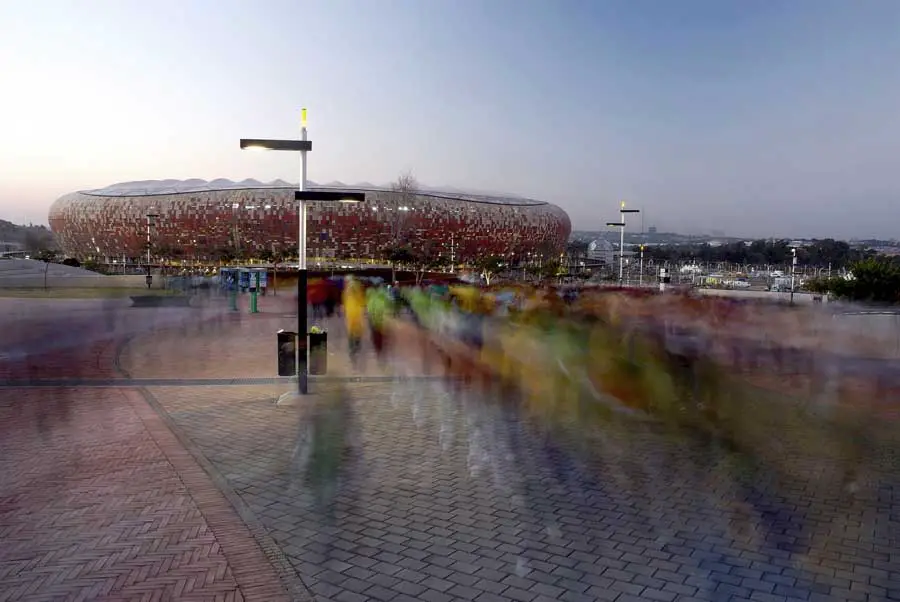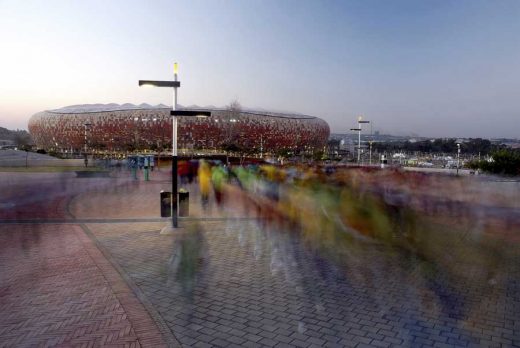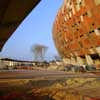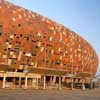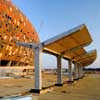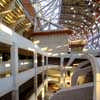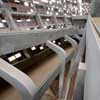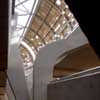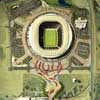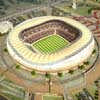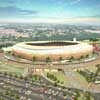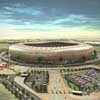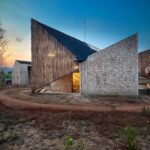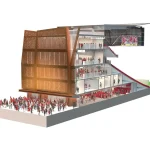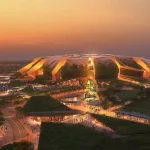Soccer City Stadium Building, African soccer ground design picture, Sports project news, Arena photo
Soccer City Stadium Africa : Arena in Johannesburg
Football Arena Development in Johannesburg, South Africa
10 Nov 2010
, South Africa
–
Design: Boogertman Urban Edge and Partners in partnership with Populous
Soccer City Stadium Johannesburg
STRUCTURAL DESIGN
P.D. Naidoo & Associates (PDNA) are the principal structural engineers for the upgrading of Soccer City. PDNA appointed a German company, Schlaich Bergermann & Partners, as a specialist roof sub-consultant to assist with the detail analysis and design of the roof and façade structures.
The existing stadium, which was first constructed in 1987, consisted of a playing field surrounded by embankment seating, 2 levels of corporate hospitality suites, and an elevated seating tier on the western side only.
The architects for this prestigious project, Boogertman Urban Edge + Partners, in association with HOK Sports Architecture, have created, an “African Pot” which will in future be recognized instantly by spectators in every corner of the world. To achieve this unique look, a structure, circular in shape on plan, was created to envelope the upgraded triple-tiered concrete seating bowl.
The circular plan format of the pot, which encircles the rectangular seating bowl and field, was selected to ensure that all façade detailing could be consistent in plan and section, thus ensuring an easier detailing, manufacture, and installation process. This furthermore ensured that the 120 concrete façade columns would be consistent in shape and form. Given that the existing concrete structure was limited in its ability to carry the additional roof load imposed on it, it was decided by the design team to remove the roof structure from the seating bowl structure and place the roof structure on 12 off-shutter concrete shafts. These shafts required an ingenious piling solution.
Piling
On completion, approximately 1350 piles will have been installed at Soccer City. The forces generated by the concrete structure and roof mean that exceptionally high loads have been transferred to the foundations, which has resulted in the design and construction of some of the most extreme piles ever installed in South Africa. All the piles and lateral support were designed by ARQ and Verdicon, and installed by GEL.
Whilst many of the piles carry large compressive loads, many piles are also subjected to exceptionally high tension loads. The calabash-shaped façade and the roof transfer the loads from the roof, down twelve reinforced concrete shafts and 120 inclined perimeter façade columns, to the piled foundations. Some shaft foundations are required to resist tension loads up to 13000kN, in combination with sheer loads of 6000kN and a bending moment of 125000kNm. Due to the limited space, it was only possible to install a maximum of 12 piles per shaft foundation, resulting in some piles being subjected to tension loads of 5800kN (580 tons). In order to accommodate the massive loads, the designers decided to anchor the piles 6m into the sandstone bedrock using dowel bars installed through the base of the pile.
In some cases the 1500 diameter piles were installed up to a depth of 33m, necessitating almost 60m³ of concrete in a single pile.
Shafts
The roof is supported by 12 large, 40m-high rectangular concrete shafts, each of which is designed to withstand large horizontal and vertical loads. The shafts vary in plan from 3.5m x 5.0m to 3.5m x 14.0m, with an average wall thickness of 600mm. A huge reinforcing steel content of 460kg/m³ (approximately three times more than normal reinforced concrete) made the placing and compaction of the concrete extremely difficult. The stiffness of the shafts under varying load combinations had to be determined accurately, as this could affect the forces in the structural steel roof structure.
The design and stiffness of the shafts were further complicated by various openings which had to be provided for electrical, mechanical, fire, domestic, and storm water services. All these services were designed early on in the process and modelled in 3D by the architects to ensure that all penetrations were fully co-ordinated, before the reinforcing was designed by the engineers. This was required as it was impossible to entertain any late requests for penetrations by the services engineers. These shafts are founded on the piled foundations described above, with some piles subjected to downward loads of 1100 tons and upward loads of 580 tons. In addition to the shafts, 16 circular columns of 1 meter diameter support the roof.
Shaft bases
In order to transfer the large loads from the roof, via the concrete shafts, into the tension and compression piles, large pile caps with depths in excess of 4m were required. The construction of these large bases required careful planning, as heat of hydration had to be controlled, and the safety of construction workers, who are often required to work beneath heavy reinforcement, had to be ensured. Varying soil conditions on site often required that the engineers had to adapt the design of these bases.
Lateral Support
To allow access into the completed stadium bowl, three deep tunnels had to be cut with vertical excavation. The western players’ tunnel runs below the existing stadium structure, and has permanent support with a maximum vertical height of up to 10.0m.
The south-west and north-east tunnels have been constructed through new portions of the stadium. Due to programming constraints, it was decided to construct permanent lateral support in these tunnels, consisting of soil nails, shotcrete, and mesh. Due to the construction of deep pile caps at the base of the north eastern tunnel, vertical lateral support heights of up to 13.0m have been constructed.
Raking Beams
In order to vastly improve the sightlines of the existing stadium, the rake of the existing western upper tier has been increased, and an additional raised seating tier has been introduced on the upper portion of the embankment. Two levels of hospitality suites and the upper tier have been completed on the northern, eastern, and southern pavilions, thereby creating a classic triple–tiered bowl. All raking beams were constructed using purpose-made formwork. The existing pre-cast steppings to the western upper tier were removed, crushed, and recycled as base layers for the bulk earthworks. All new seating steppings are constructed from pre-cast concrete, all made on site.
Pre-Cast yard and pre-cast elements
To reduce the handling time and damage to precast units, as well as to achieve a value-for- money product, GLTA/Interbeton elected to establish an on-site batching plant and pre-cast yard. This allowed for easy inspection and control of the units, which were all unique in dimension due the existing geometry of the old stadium bowl, allowing them to be placed correctly with the minimum amount of handling.
Façade Columns
One of the most challenging elements of the concrete structure was the design and construction of the façade columns. The façade structure is supported on 120 inclined concrete columns enveloping the stadium. The columns are 16.3m high, and the top of each of these columns has a horizontal eccentricity of 6.5 metres in relation to its base, resulting in large moments and upward loads on the piled foundations. Due to the large moments and forces in these slender columns, the reinforcing steel is extremely dense (860 kg/m³), which made the use of a vibration poker extremely difficult.
GLTA/Interbeton opted to use self-compacting concrete to construct these columns. All façade columns are connected with tie beams which act in ring tension so as to limit long-term deflection of the columns and façade structure. The design and construction of the façade columns had to be planned and executed very carefully, with temporary propping and bracing, so as to prevent deflection during construction. It is interesting to note that the temporary steel required for the live and dead ends of the facade columns will be recycled by the architects, with the help of a group of artists, into artworks that will have pride of place on the podium and within the Nasrec precinct.
Façade cladding
The final selection of the façade material came about after an extensive search by the architects to select a product that would ultimately reflect the nature of the concept of the calabash. Having discarded ideas of composite aluminium, steel, and various roof-sheeting options, the architects were coincidently introduced to an extruded fibre reinforced concrete panel called Fibre C, from Rieder Elements in Austria. The product is supplied in panels with varying surface finishes, honed and sandblasted, in combination with a variety of earthy colours, to create the unique variegated façade cladding.
The panels, which are light-weight and only 13mm in thickness, are supplied in 1200 x 1800mm typical panel sizes and are fixed to a galvanised steel sub frame. The panels, furthermore, have excellent thermal properties and have been subjected to rigorous testing, including hail impact, water penetration, and discolouration tests.
Ramps
Eight large pedestrian ramps, designed for the efficient ingress and egress of spectators to the upper levels of the stadium, have been provided. These ramps, which also provide vehicular access to all levels, follow the shape of the façade bowl and consequently change position in plan from one level to the next. In addition to the sloped façade columns, the other columns supporting the ramps are inclined thereby requiring intricate design analysis and construction techniques.
TRAINING
Due to the critical skills shortage in the construction industry, the Soccer City project embarked on an extensive training initiative to provide the necessary skills required by the project and to contribute to the development of the local community. A self-sustaining training centre was established by the Soccer City project near the site, in conjunction with a black economic empowerment (BEE) training provider. Training was conducted in the following disciplines, according to the relevant unit standards:
• Crane Operations
• Shutterhand
• Concrete hand
• Construction Supervisor
• Foreman
• Construction Plant Operator
All new trainees were assessed through a Learner Ability Battery Test, which is non-discriminatory and is used to determine literacy, numeracy, and development potential. All currently employed core and limited duration employees are offered the opportunity for further training and development to enhance their skills and further their construction careers. The training centre assessed 907 unemployed learners and trained 798 learners.
Apart from the training initiative, a large number of the unemployed learners were offered employment at Soccer City.
SOCIAL UPLIFTMENT
As part of their Corporate Social Investment programmes, GLTA/Interbeton have agreed to construct two classrooms at the Bella Primary School in Soweto, opposite the Hector Pieterson Museum. To this end, Boogertman Urban Edge + Partners and PDNA have provided, at no cost, the architectural and engineering services respectively for this worthy cause.
PEOPLE
At present there are in excess of 2600 people on site. This excludes the hundreds more in the various subcontract workshops scattered around South Africa and internationally. There are also 27 different professionals that have been appointed by Phumaf, the principal agent acting on behalf of the client body led by the City of Johannesburg 2010 office.
Soccer City Stadium – Building Information
SEATS: 94,000
CONCRETE VOLUME: 80,000 m³
REBAR: 9,000 ton
FORMWORK: 174,000 m²
SLABS: 65,000 m²
PILES: 1,350
PRECAST ELEMENTS: 14,000
STRUCTURAL STEEL: 7,100 ton
CLADDING: 38,000 m²
EXCAVATION: 105,000 m³
EARTH FILL: 45,000 m³
BRICKWORK: 80,000 m²
ROOF FABRIC: 370,000 m²
Soccer City Stadium images / information from Boogertman Urban Edge and Partners
Soccer City Stadium Building – main page
Location: Nasrec Road, Soweto, Johannesburg, South Africa
African Buildings
World Cup Stadiums South Africa
South African Architecture – Selection:
Portside Cape Town, South Africa
New bush house in the Shona Langa eco estate, Mabula district, Limpopo Province
Design: A4AC Architects | Architecture for a change (pty)Ltd
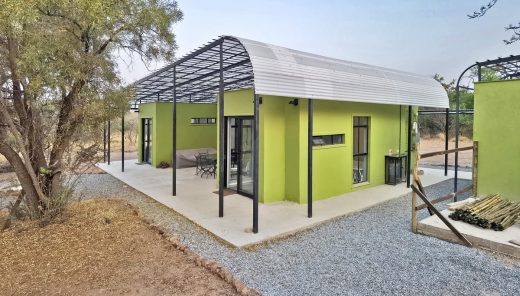
photo : Ernst van Biljont
Green House in Shona Langa eco estate
Comments / photos for the Soccer City Stadium Africa – Johannesburg Architecture page welcome

